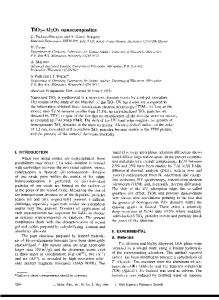Formation of Al 2 O 3 during heating of an Al/TiO 2 nanocomposite powder
- PDF / 1,805,566 Bytes
- 7 Pages / 612 x 792 pts (letter) Page_size
- 7 Downloads / 429 Views
D.Y. Ying Bioengineering Technologies Team, HortResearch, Ruakura Research Centre, Hamilton 2001, New Zealand
P. Munroe Electron Microscope Unit, University of New South Wales, Sydney 2052, Australia (Received 26 March 2004; accepted 6 May 2004)
The solid-state reactions between Al and TiO2 that occur during heating an Al/TiO2 nanocomposite powder produced using high-energy mechanical milling have been studied using thermal analysis, x-ray diffractometry (XRD), scanning electron microscopy (SEM), and transmission electron microscopy (TEM) in combination with compositional microanalysis. It has been found that Al and TiO2 react in the temperature range from 650 to 800 °C, forming Al3Ti, but XRD analysis, SEM examination, and detailed TEM characterization of the powder particles heated to 800 °C show that the expected Al2O3 does not form. However, ␣–Al2O3 particles form during heating from 800 to 1000 °C. The possible reasons for the time gap between formation of Al3Ti and Al2O3 are discussed.
I. INTRODUCTION
The reactions between Al and TiO2 are of a great interest to many materials researchers since they lead to the formation of titanium aluminides (Al3Ti, TiAl, or Ti3Al) and alumina (Al2O3). Al3Ti and Al2O3 phases produced by these reactions have been used as reinforcement phases for in situ aluminium alloy-based metal matrix composites,1–8 while the combinations of TiAl or Ti3Al and Al2O3 produced by these reactions have been used for production of in situ aluminide–alumina composite materials.9–14 The Al2O3 phase has several polymorphous variations including the ␦, , ␥, and ␣ phases. The ␣–Al2O3 needed as the reinforcement phase in the composites is normally not the phase formed directly from the reaction between Al and TiO2 and requires heating to a higher temperature2 or holding the material at an elevated temperature for a lengthy time3 to form. The recent work by Ying et al.15 has shown that when Al/ TiO2 composite powders produced by high-energy ball milling are heated to a sufficiently high temperature, Al and TiO2 react causing Al3Ti to form, but x-ray analysis
a)
Address all correspondence to this author. e-mail: [email protected] DOI: 10.1557/JMR.2005.0059 J. Mater. Res., Vol. 20, No. 2, Feb 2005
http://journals.cambridge.org
Downloaded: 01 Apr 2015
and scanning electron microscopy examination indicate that the expected Al2O3 does not form at the same time. The Al2O3 forms after the powders are heated to temperatures substantially higher than the temperatures at which the majority of Al3Ti forms. This means that in the transient stage, the oxygen coming out of TiO2 during the reaction has to exist in a form other than Al2O3. To clarify the process of the formation of Al2O3 in the reactions between Al and TiO2, a more detailed investigation using transmission electron microscopy in combination with compositional microanalysis has been conducted, and this paper reports the findings of this investigation. II. EXPERIMENTAL TECHNIQUES
The Al/TiO2 composite powder was produced by highenergy mil
Data Loading...











